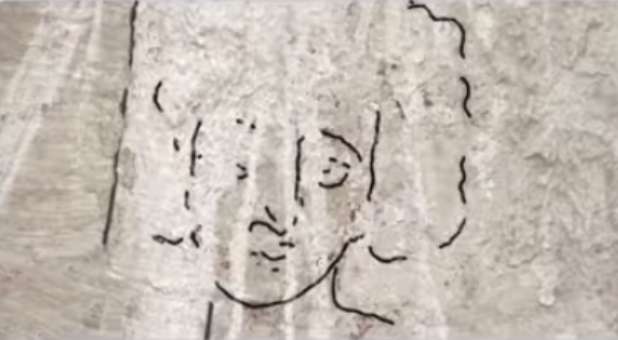An early depiction of what is thought an image of a young Jesus has been found on the wall of an approximately sixth century A.D. Byzantine era church in Israel’s Negev Desert. It was discovered in Shivta, approximately 25 miles southwest of Beersheba, by a team of Haifa University researchers.
Art historian Dr Emma Maayan-Fanar, along with Haifa University archaeologists and conservationists Prof. Guy Bar-Oz, Yotam Tepper and Ravit Linn, are participating in a multi-year interdisciplinary research project called the Negev Byzantine Bio-Archaeology Research Program at the UNESCO World Heritage Site. One of the project’s main aims is to reveal why Shivta, a relatively prosperous and large village—which had three churches—during its fifth-to-sixth century A.D. peak, suddenly declined in the early Islamic period (seventh to late ninth centuries A.D.).
Maayan-Fanar said that on a recent trip to Shivta, she was visiting the apse of the baptistry chamber in the northern church and chanced to look up. What she saw had been briefly noted by archaeologists almost 100 years previously, but she was certain that it was something significant.
According to the journal Antiquity, the painting despite its fragmentary condition “reveals a youth’s face depicted on the apse’s upper section (Figure 5). The figure has short curly hair, a prolonged face, large eyes and an elongated nose. The neck and upper portion are also observable. To the left of the figure, another, much larger face surrounded by a halo.” The research team wrote that the face, set in a larger depiction of Jesus’ baptism, is “the first pre-iconoclastic baptism-of-Christ scene to be found in the Holy Land.” The researchers posited that the second face could be a depiction of John the Baptist.
In Western art, Jesus is usually depicted as having long, at-least shoulder-length hair, with a full beard, however there was an iconographic tradition in Egypt and Syro-Palestine for him to be depicted with short curly hair. However, the practice was relatively short-lived and had died out later in the Byzantine era. It is this that helped the researchers date the probable creation of the painting as during the sixth century A.D.
To the untrained eye, the image’s faint lines may be difficult to decipher. However, for non-layman, there are telltale signs that the image does indeed depict what the researchers claim. According to Maayan-Fanar, there is little doubt. Early Christian art and iconography follow well-known formulaic patterns, she said.
“Those who know the iconography of early Christianity can recognize such an image even from almost nothing,” she said.
Only sketchy information is known about Shivta. Some scholars suggest that it was settled by the nomadic Nabateans, who until Roman innovation and might replaced them in the second century A.D., ruled the Spice Route—due to their knowledge of winds—through much of the Fertile Crescent. {eoa}
Breaking Israel News offers a fresh and biblical perspective on the latest news from Israel and the Middle East. Our bias is not liberal nor conservative—just biblical.
This article originally appeared at breakingisraelnews.com.
See an error in this article?
To contact us or to submit an article






















